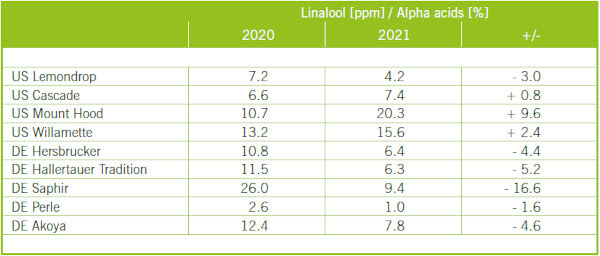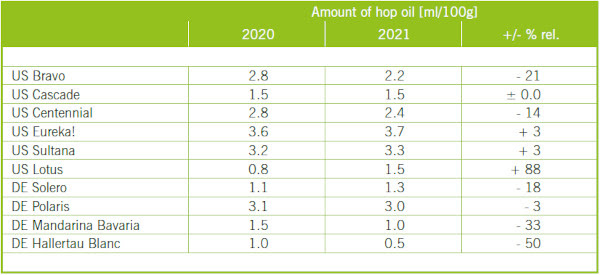Stan Hieronymus Hop Queries – January 2022 January 2022
Each month respected beer writer Stan Hieronymus produces Hop Queries, a must-read summary of what is happening in the hop world, and has kindly offered to let us publish it for Australian industry readers. If you would like to subscribe directly, you can here.
- Saaz harvest surprises
- Call her Vista
- Oil check
- USA Hops statistics
- Hop stunt viroid
- Cascade Cup winners
- A hop called Most
- Book recommendations
Welcome to Vol. 5, No. 9. My Instagram feed was full of pictures of snow-covered hop fields to start the month. Now I’m starting to see hops from the southern hemisphere in full burr.
Bountiful Saaz hop harvest
The day after Vol. 5, No. 8 hit your email box the Czech Republic reported surprisingly good news about the 2021 harvest, so good I thought it merited posting immediately at Appellation Beer. If you are a regular visitor there feel free to skip head at to the next section.
When June and July hailstorms hammered about 20 percent of the hop fields in Czechia, and 750 acres of 12,278 planted were described as a total loss, nobody could have expected that the 2021 harvest would turn out to be the best in 25 years. That’s what can result from a proper amount of rain and mild temperatures in July and August.
Czech farmers harvested 18.2 million pounds of hops (for perspective, that’s about as much as Americans grow of Citra alone), 40 percent more than 2020 and 34 percent more than the 10-year average. Average yield of 1,467 pounds per acre was an all-time high. (American farmers average 1,900.)
The Saaz variety accounts for 80 percent of per cent of production, and the 14.7 million pounds harvested easily exceeded the 10-year average of 10.9 million pounds. In addition, alpha averaged 4 percent, compared to the 10-year average of 3.1 percent.
As a result, Bohemia Hop reports that as well as fulfilling all contracts for Saaz this year it will be possible to fulfill postponed volumes from previous crops, and satisfy additional demand.
Call her Vista
The Agricultural Research Center has given the experimental USDA hop previously known as 2006009-074 a name, Vista, and is making her available to hop farmers across the country. Genetic material has been deposited in the National Clean Plant Network and is available for purchase.
Vista is the daughter of an open-pollinated tetraploid Perle plant. Adjectives attached to the aroma of beers brewed with 074 included orange, lime peel, tropic, floral and stone fruit. As important, she is high yielding, drought/heat tolerant and has thrived in hop growing regions beyond the Washington, Idaho and Oregon.
What this means is that hop farmers outside the Northwest – as well as those in Washington, Idaho and Oregon, of course – will have another New World variety that grows well in their region. And brewers who want to use local hops – but are not ready to forsake those with the newest, never-tasted-this-before flavors – will have an option that checks both boxes.
Time for an oil check
Like last year (Vol. 4, No. 9), Hopsteiner has provided averaged data on the composition of aroma substances of some hop varieties harvested in 2021. The first chart shows the ratio of linalool to alpha acids and is recommended to assess aroma intensity. If the ratio of linalool is lower compared to 2020 then more hops will be needed to match the current sensory profile. Obviously, some adjustments must then be made for bitterness.
The second chart lists essential oil content of varieties often used for dry hopping. One reason Hopsteiner includes this is that some breweries make dry hopping additions based on total essential oil.


USA Hops statistics
The Hop Growers of America statistical packet is available to download. There are plenty of takeaways, but this one is worth revisiting. Since 2012, US hop acreage has increased 109 percent, from 29,683 to 62,259 acres. During that period the variety balance shifted from roughly 50/50 alpha and aroma hops in 2012 to 80.5 percent aroma varieties in 2021.
Hop stunt: A warning
I wrote about hop stunt viroid (HSVd) and Cascade hops for Brewing Industry Guide this month. HSVd is a disease that was first identified in Northwest hop fields less than 20 years ago. It can significantly reduce the yield of some varieties, including Cascade. This does not mean Cascade is in danger of disappearing. It is a reminder that when brewers don’t signal interest in a variety, particularly one that faces additional disease pressure, growers will plant something else.
But the real reason I am mentioning the story is because it is essential for those of you who grow hops to remember the importance of starting with clean stock and following best practices in the field. Here’s a handy primer.
Cascade Cup winners
Considering the importance of Cascade, it is the variety the Hop Quality Group chose in 2013 when they began a friendly competition to showcase growers. Last week, B&D Farms in St. Paul, Oregon, won the cup for the third time. B&D won previously in 2016 and 2019, as well as capturing third in 2018. Jackson Farms in Wilder, Idaho, was second, and last year’s winner, Coleman Greenleaf, was third.
Further reading I: Most hops
A blog post from Jordan St. John’s blog starts out about Czech-grown hop variety Most and turns into something more. I just want to add one bit of information. Although the place hops are grown (terroir) may impact their flavor and aroma the cultivar (variety) itself still makes the greatest difference.
Most (which is pronounced mosst and means “bridge”) is a product of the Charles Faram Inc. breeding program. The cross that produced a seed known as CF111 was made in England, then the seed was sent to Czechia to planted. She performed well enough as an experimental to earn a name. She is a daughter of Cascade, so her tropical citrus punch aroma with lemon, lime and lemongrass shouldn’t be a surprise.
She’s different than her sisters, Jester and Olicana, both grown in England, but not that different.
Further reading II: Aroma & flavor
A newish site (still in beta) called “Shepard: Discover the Best Books” asked me to contribute to their list of “best books.” They might have been expecting 5 beer books, but instead I suggested 5 about aroma and flavor, because when I began research on “For the Love of Hops” about 70 percent of the hops grown worldwide were valued simply for the bitterness they added to beer. That was about to change – see “all the statistics” above – and I needed to know more about the sense of smell.
Topics to explore?
Thank you for subscribing. If you have queries you’d like to see addressed drop me a line at stan@appellationbeer.com.

